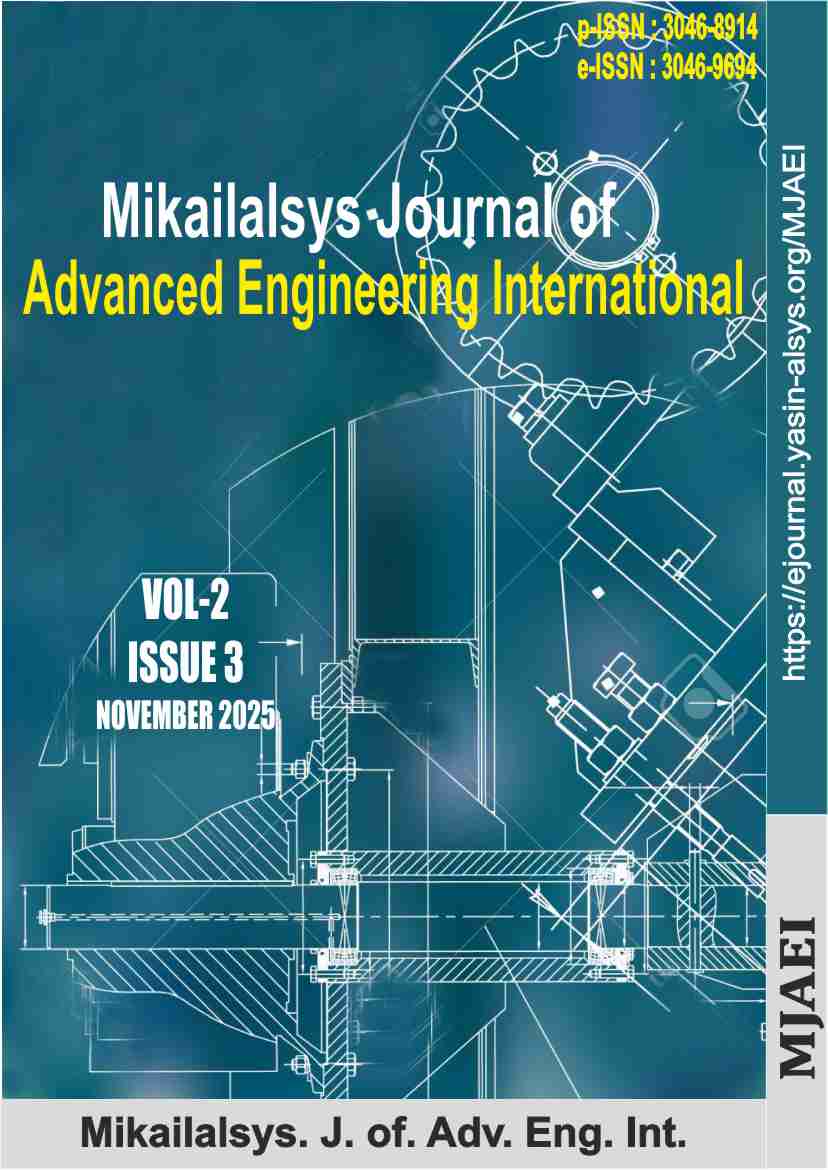Simulation Study of an Arduino-Driven Heart Monitoring System for Maternal Well-Being

Main Article Content
Abstract
Maternal cardiovascular health significantly influences pregnancy outcomes; however, conventional monitoring practices often depend on sporadic clinical evaluations, hindering the prompt identification of potential abnormalities. This study presents the design and simulation of a cost-effective, Arduino-based maternal heart monitoring system intended to facilitate early detection of cardiovascular irregularities during pregnancy. The system was developed using Proteus 8.15 simulation software and comprises an Arduino Uno microcontroller, a virtual heartbeat sensor, an LCD display, LED indicators, and buzzer alarms. The simulated environment replicates real-time physiological signal acquisition, processing, classification, and alert generation across various heart rate scenarios, including bradycardia, tachycardia, and normal rhythms. The system accurately classified these conditions and triggered appropriate audiovisual alerts during abnormal episodes. Signal fidelity was verified using a virtual oscilloscope, and the system reliably identified critical thresholds such as severe bradycardia (≤25 BPM) and tachycardia (≥145 BPM). These results underscore the potential of the proposed solution as an offline, low-cost monitoring tool particularly suitable for deployment in resource-constrained settings. Future research should advance this work through physical prototyping, integration with fetal monitoring systems, and empirical validation in clinical and rural contexts to assess its practical efficacy and scalability.




Citation Metrics:


Downloads
Article Details

Authors retain copyright and grant the journal right of first publication with the work simultaneously licensed under a Creative Commons Attribution-NonCommercial-ShareAlike 4.0 International License that allows others to share the work with an acknowledgement of the work's authorship and initial publication in this journal.
References
Adeyemo, T. A., & Salawu, B. T. (2022). Challenges in biomedical engineering education in developing countries: Simulation and prototyping gap. African Journal of Health Technology, 8(2), 98–104.
Aliyu, U. A., & Dantata, S. D. (2023). Simulating maternal cardiovascular parameters using embedded systems. Nigerian Journal of Health Technology, 8(1), 55–63.
Al-Turjman, B., & Zomaya, A. (2022). Machine learning for biomedical sensor calibration. Sensors, 22(8), 2831. https://doi.org/10.3390/s22082831
Bartholomew, E. J. (2020). Teaching embedded medical systems with Proteus. Journal of Biomedical Education, 28, 84–90.
Bhuyan, M. H., & Hasan, M. (2020). Design and simulation of a heartbeat measurement system using an Arduino microcontroller in Proteus. International Journal of Biomedical and Biological Engineering, 14(10), 350–357.
Cain, B. M., White, K. L., & Johnson, A. W. (2024). Heart rate variability and its predictive value in obstetric medicine. Journal of Maternal-Fetal & Neonatal Medicine, 37(2), 155–161.
Ford, N. D., (2022). Hypertensive disorders in pregnancy and mortality at delivery hospitalization—United States, 2017–2019. MMWR, 71(17), 585–591.
Ghamari, H. (2018). A survey on monitoring and diagnostic medical wearable systems. Sensors, 18(1), 185. https://doi.org/10.3390/s18010185
Green, C. F., Ali, A. H., & Patel, N. (2020). ECG signal simulation for wearable system evaluation. IEEE Journal of Biomedical and Health Informatics, 24(6), 1762–1769.
Hawryszko, M., Sławiński, G., Kozłowski, D., & Lewicka, E. (2022). Apple Watch-guided diagnosis of AVNRT in a pregnant woman—A case report and literature review. Frontiers in Cardiovascular Medicine, 9, 985421. https://doi.org/10.3389/fcvm.2022.985421
Islam, M. S., & Hasan, M. (2021). Design and simulation of a pulse monitoring system using Arduino and Proteus. International Journal of Biomedical Engineering and Technology, 32(3), 215–225.
Jasinski, S. R. (2024). Wearable-derived maternal heart rate variability as a novel digital biomarker of preterm birth. PLOS ONE, 19(1), e0295899. https://doi.org/10.1371/journal.pone.0295899
Kerrigan, E. L. (2023). Pregnancy as an early cardiovascular moment: Peripartum cardiovascular health. Cardiovascular Medicine Reviews, 12(3), 145–157.
Khandpur, R. (2023). Biomedical instrumentation: Technology and applications (3rd ed.). McGraw-Hill.
Kolb, J., Napp, P., & Egger, M. D. (2022). Diagnosis of arrhythmias using wearable devices during pregnancy: A case-based review. Journal of Electrocardiology, 73, 55–59.
Mandal, S., & Choudhury, D. (2022). Development of a heart rate monitoring system using the Arduino platform for maternal healthcare. Journal of Medical and Biomedical Science, 12(2), 89–97.
Melchiorre, S., & Sania, S. G. (2024). Cardiovascular complications of pregnancy. Clinical Obstetrics and Gynecology, 68(1), 1–12.
Nasir, S. Z. (2017, November). Heartbeat sensor library V2.0 for Proteus. The Engineering Projects. https://www.theengineeringprojects.com/2017/11/heart-beat-sensor-library-proteus.html
Pantelopoulos, M., & Bourbakis, N. G. (2010). A survey on wearable sensor-based systems for health monitoring and prognosis. IEEE Transactions on Systems, Man, and Cybernetics C, 40(1), 1–12.
Rajkumar, T., Hennessy, A., & Makris, A. (2025). Remote blood pressure monitoring in pregnancies at risk of developing pre-eclampsia. Current Hypertension Reports, 27(1), 15.
Rehan, M., & Sultana, S. (2021). Data logging and format structuring in health monitoring devices. IEEE Access, 9, 88123–88134.
Schumacher, A. (2023). Changes in heart rate, HRV, breathing rate, and skin temperature throughout pregnancy using a sensor bracelet: A longitudinal study. Sensors, 23(14), 6620.
Simpson, C. J. (2024). Cardiac physiology and pathophysiology in pregnancy. Canadian Journal of Physiology and Pharmacology, 103(2), 85–99.
Stricker, K., Radan, A.-P., & Surbek, D. (2025). Continuous remote home monitoring solutions for mother and fetus: A scoping review. European Journal of Obstetrics & Gynecology and Reproductive Biology, 305, 170–177.
Tadesse, M. (2024). Burden and outcomes of hypertensive disorders of pregnancy in Ethiopia: A systematic review and meta-analysis. BMC Pregnancy and Childbirth, 24, 125.
Wang, H., & Xue, Y. (2020, July). Design and simulation of a heartbeat rate display system based on Arduino. Proceedings of the IEEE International Conference on Mechatronics and Automation (pp. 303–308).
Wheat, H., & Davis, M. (2024, September 17). Arrhythmias in pregnancy—Expert analysis. American College of Cardiology.
Yaqoob, S., Shah, I. A., Khan, M. A., & Shabbir, A. (2022). Privacy and security challenges in e-health cloud-based systems: A review. IEEE Access, 10, 11389–11401.
Zain, A. B., & Ali, S. M. (2021). Modular Arduino programming for biomedical signal processing. Journal of Engineering and Applied Sciences, 17(1), 45–52.
Find the perfect home for your research! If this journal isn't the right fit, don't worry—we offer a wide range of journals covering diverse fields of study. Explore our other journals to discover the ideal platform for your work and maximize its impact. Browse now and take the next step in publishing your research:
| HOME | Yasin | AlSys | Anwarul | Masaliq | Arzusin | Tsaqofah | Ahkam | AlDyas | Mikailalsys | Edumalsys | Alsystech | AJSTEA | AJECEE | AJISD | IJHESS | IJEMT | IJECS | MJMS | MJAEI | AMJSAI | AJBMBR | AJSTM | AJCMPR | AJMSPHR | KIJST | KIJEIT | KIJAHRS |















